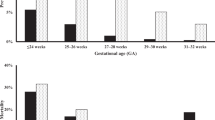Abstract
Objective:
To examine discharge outcomes of extremely low birth weight infants (ELBW) with spontaneous intestinal perforation (SIP).
Study design:
A single-center retrospective cohort study of all ELBW infants admitted to the University of Virginia neonatal intensive care unit between July 1996 and June 2004.
Results:
We found 35 patients with SIP (incidence 8.4%). The median gestational age was 25 weeks, median birth weight was 722 g, and 71% of the infants were male. Most infants (n=28) with SIP were diagnosed secondary to pneumoperitoneum; however, one-third (7) of infants <25 weeks had occult presentations without pneumoperitoneum. When controlled for gestational age, gender, multiple gestation, indomethacin, and glucocorticoid exposure, infants with SIP have a higher risk of PVL and death than infants without perforation.
Summary:
Periventricular leukomalacia and death are significantly associated with SIP in ELBW after adjusting for gestational age, multiple gestation, indomethacin, and glucocorticoid exposure.
This is a preview of subscription content, access via your institution
Access options
Subscribe to this journal
Receive 12 print issues and online access
$259.00 per year
only $21.58 per issue
Buy this article
- Purchase on Springer Link
- Instant access to full article PDF
Prices may be subject to local taxes which are calculated during checkout



Similar content being viewed by others
References
Thelander HE . Perforation of the gastrointestinal tract of the newborn infant. Am J Dis Child 1939; 58 (2): 371–393.
Gandhi RK . Spontaneous intestinal perforation in the newborn. J Roy Coll Surg 1961; 6: 293–301.
Alpan G, Eyal F, Vinograd I, Udassin R, Amir G, Mogle P et al. Localized intestinal perforations after enteral administration of indomethacin in premature infants. J Pediatr 1985; 106 (2): 277–281.
Aschner JL, Deluga KS, Metlay LA, Emmens RW, Hendricks-Munoz KD . Spontaneous focal gastrointestinal perforation in very low birth weight infants. J Pediatr 1988; 113 (2): 364–367.
Gordon P, Rutledge J, Sawin R, Thomas S, Woodrum D . Early postnatal dexamethasone increases the risk of focal small bowel perforation in extremely low birth weight infants. J Perinatol 1999; 19 (8 Part 1): 573–577.
Garland JS, Alex CP, Pauly TH, Whitehead VL, Brand J, Winston JF et al. A three-day course of dexamethasone therapy to prevent chronic lung disease in ventilated neonates: a randomized trial. Pediatrics 1999; 104 (1 Part 1): 91–99.
Stark AR, Carlo WA, Tyson JE, Papile LA, Wright LL, Shankaran S et al. Adverse effects of early dexamethasone in extremely-low-birth-weight infants. N Engl J Med 2001; 344 (2): 95–101.
Watterberg KL, Gerdes JS, Cole CH, Aucott SW, Thilo EH, Mammel MC et al. Prophylaxis of early adrenal insufficiency to prevent bronchopulmonary dysplasia: a multicenter trial. Pediatrics 2004; 114 (6): 1649–1657.
Gordon PV, Young ML, Marshall DD . Focal small bowel perforation: an adverse effect of early postnatal dexamethasone therapy in extremely low birth weight infants. J Perinatol 2001; 21 (3): 156–160.
Halliday HL, Ehrenkranz RA, Doyle LW . Early postnatal (<96 h) corticosteroids for preventing chronic lung disease in preterm infants. Cochrane Database Syst Rev 2003; (1): CD001146.
Hwang H, Murphy JJ, Gow KW, Magee JF, Bekhit E, Jamieson D . Are localized intestinal perforations distinct from necrotizing enterocolitis? J Pediatr Surg 2003; 38 (5): 763–767.
Tatekawa Y, Muraji T, Imai Y, Nishijima E, Tsugawa C . The mechanism of focal intestinal perforations in neonates with low birth weight. Pediatr Surg Int 1999; 15: 549–552.
Holland AJ, Shun A, Martin HC, Cooke-Yarborough C, Holland J . Small bowel perforation in the premature neonate: congenital or acquired? Pediatr Surg Int 2003; 19 (6): 489–494.
Rovin JD, Rodgers BM, Burns RC, McGahren ED . The role of peritoneal drainage for intestinal perforation in infants with and without necrotizing enterocolitis. J Pediatr Surg 1999; 34 (1): 143–147.
Camberos A, Patel K, Applebaum H . Laparotomy in very small premature infants with necrotizing enterocolitis or focal intestinal perforation: postoperative outcome. J Pediatr Surg 2002; 37 (12): 1692–1695.
Cass DL, Brandt ML, Patel DL, Nuchtern JG, Minifee PK, Wesson DE et al. Peritoneal drainage as definitive treatment for neonates with isolated intestinal perforation. J Pediatr Surg 2000; 35 (11): 1531–1536.
Sharma R, Tepas III JJ, Mollitt DL, Pieper P, Wludyka P . Surgical management of bowel perforations and outcome in very low-birth-weight infants. J Pediatr Surg 2004; 39 (2): 190–194.
Uceda JE, Laos CA, Kolni HW, Klein AM . Intestinal perforations in infants with a very low birth weight: a disease of increasing survival? J Pediatr Surg 1995; 30 (9): 1314–1316.
Shorter NA, Liu JY, Mooney DP, Harmon BJ . Indomethacin-associated bowel perforations: a study of possible risk factors. J Pediatr Surg 1999; 34 (3): 442–444.
Blakely ML, Lally KP, McDonald S, Brown RL, Barnhart DC, Ricketts RR et al. Postoperative outcomes of extremely low birth-weight infants with necrotizing enterocolitis or isolated intestinal perforation. Ann Surg 2005; 241 (6): 984–994.
Thomas P, Peabody J, Turnier V, Clark RH . A new look at intrauterine growth and the impact of race, altitude, and gender. Pediatrics 2000; 106: 21–26.
Kuo S, Alford BA, Burns RC, Gordon PV . Hemoperitoneum versus bowel perforation in the extremely low birth weight infant. Pediatr Int 2004; 46 (5): 601–604.
Kramer MS, Platt RW, Wen SW, Joseph KS, Allen A, Abrahamowicz M et al. A new and improved population-based canadian reference for birth weight for gestational age. Pediatrics 2001; 108 (2): e35–e41.
Chen CC, Huang CB, Chung MY, Huang LT, Yang CY . Periventricular echogenicity is related to delayed neurodevelopment of preterm infants. Am J Perinatol 2004; 21 (8): 483–489.
SAS Institute Inc. SAS/STAT User's Guide, Version 9.1. SAS Institute Inc.: Cary, NC; (2003).
Stokes ME, Davis CS, Koch GG . Categorical Data Analysis Using the SAS® SYSTEM. 2nd edn, SAS Institute Inc.: Cary, NC; (2000).
Haberman S, Burgess T, Klass L, Cohn BD, Minkoff HL . Acute bowel perforation in a fetus with gastroschisis. Ultrasound Obst Gyn 2000; 15 (6): 542–544.
Miller SF, Seibert JJ, Kinder DL, Wilson AR . Use of ultrasound in the detection of occult bowel perforation in neonates. J Ultrasound Med 1993; 12 (9): 531–535.
Sherwin C, Fern R . Acute lipopolysaccharide-mediated injury in neonatal white matter glia: role of TNF-alpha, IL-1beta, and calcium. J Immunol 2005; 175 (1): 155–161.
Pang Y, Cai Z, Rhodes PG . Effects of lipopolysaccharide on oligodendrocyte progenitor cells are mediated by astrocytes and microglia. J Neurosci Res 2000; 62 (4): 510–520.
Hintz SR, Kendrick DE, Stoll BJ, Vohr BR, Fanaroff AA, Donovan EF et al. Neurodevelopmental and growth outcomes of extremely low birth weight infants after necrotizing enterocolitis. Pediatrics 2005; 115 (3): 696–703.
Acknowledgements
We thank Dr John Kattwinkel for his editorial comments, and Jessica Paxton for her technical editing of the manuscript. Dr Gordon received support from NIH Grant 1KO8DK/HD61553-01.
Author information
Authors and Affiliations
Corresponding author
Rights and permissions
About this article
Cite this article
Attridge, J., Herman, A., Gurka, M. et al. Discharge outcomes of extremely low birth weight infants with spontaneous intestinal perforations. J Perinatol 26, 49–54 (2006). https://doi.org/10.1038/sj.jp.7211407
Received:
Revised:
Accepted:
Published:
Issue Date:
DOI: https://doi.org/10.1038/sj.jp.7211407
Keywords
This article is cited by
-
Delayed diagnosis of spontaneous intestinal perforation among very low birth weight neonates: A single center experience
Journal of Perinatology (2019)
-
Association of in utero magnesium exposure and spontaneous intestinal perforations in extremely low birth weight infants
Journal of Perinatology (2017)
-
Neonatal Gastrointestinal Perforations: the 10-Year Experience of a Reference Hospital
Indian Journal of Surgery (2017)
-
Ultrasound to diagnose spontaneous intestinal perforation in infants weighing ⩽1000 g at birth
Journal of Perinatology (2015)
-
Can a national dataset generate a nomogram for necrotizing enterocolitis onset?
Journal of Perinatology (2014)



